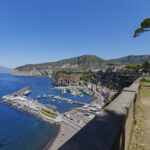Vico Equense, Villa Giusso Astapiana ai Camaldoli set of the film by Paolo Sorrentino "It was the hand of God".
Not only Naples, Paolo Sorrentino’s film also takes us to the wonderful landscapes of the Sorrento Peninsula. The large house where the whole family gathers in the summer for lavish lunches and swimming in the sea is the Villa Giusso Astapiana in Vico Equense, a former farmhouse inhabited by monks which now hosts events.
History
Astapiana Villa Giusso is mentioned for the first time (with the ancient name of Astichiano) in 1578 by Monsignor Sacra, who, in one of his apostolic reports, lamented the state of ruin of the ancient church of S. Maria in Jerusalem, probably of Angevin-Aragonese origin. The particularly suggestive place was already inhabited in Roman times and was most likely one of the numerous hillside farmhouses scattered in the area during the Angevin-Aragonese period.
At the beginning of the 17th century, the area of Vico Equense was chosen for the erection of a Camaldolese monastery and in 1604 the complex was built thanks to the generosity of Matteo di Capua, prince of Conca and feudal lord of Vico Equense, who donated the necessary land , and of Cesare Zaffarano who made a large bequest in favor of the Camaldolese. Twelve cells were built for the monks and two guesthouses, one of which was of considerable size and value for its majolica kitchen. Furthermore, a double wall was built on which two turrets stood out. It was inhabited by hermits until 1807, when Giuseppe Bonaparte, then king of Naples, suppressed the religious orders and confiscated their goods. In 1815, after the defeat against Austria, Gioacchino Murat took refuge there for a few days. The complex was therefore part of the royal sites until 1822, when it was purchased by Duke Luigi Giusso, a Genoese banker, who planted an experimental production there for the kingdom: sericulture. It had an excellent start, but after a few decades it had to be abandoned, following an epidemic that decimated the silkworms and eliminated this type of breeding from the Sorrento peninsula. The Duke therefore renounced his innovative intentions and transformed the guest house into a country residence, a function he held throughout the twentieth century. Since then, the site has acquired its current name, Astapiana Villa Giusso.
Various generations of the Giusso family have now taken turns and the current descendants are directly involved in the estate.

The farm
The company, located at 420 m above sea level, in a splendid natural position overlooking the Sorrento peninsula, consists of various buildings and is surrounded by about 14 hectares of land, partly cultivated (olive groves, vineyards and vegetable gardens), partly spontaneous (chestnut woods). Numerous activities: a very large area is occupied by olive trees and where the soil is drier we find the vineyards. Then there is the area for farmyard animals: hens, turkeys, ducks, geese, rabbits and this year Margherita, daughter of Carolina, our cow has also arrived. In the chestnut woods you have the opportunity to go for walks and naturalistic observations. In the area closest to the buildings and rainwater cisterns, we find the vegetable gardens, the corner of aromatic plants and the trees of the “ancient fruit” (sorbi, jujube, centuries-old strawberry trees). The olive grove The olive grove has its roots in the mists of time, when in 1600, on this “chiana”, now called Astapiana, the white friars of the Camaldolese order stopped and planted the first olive tree seedlings. The ancient vocation of this land still lives today thanks to Giovanna, descendant of the “pioneer” Luigi Giusso and convinced follower in the footsteps of her ancestors, who, after the various events of the last centuries, started the process of requalification of the production and of improving the quality of the oil, thanks also to the experimental fields carried out by the projects of the Campania Region and to the collaboration of valid agronomists. Giovanna’s passion and tenacity have borne fruit from 2005 onwards, when, with the first production of extra virgin olive oil, the recognition of the Dop Penisola Sorrentina brand also arrived and attention was focused on the monovarietal product, Minucciola in purity.






